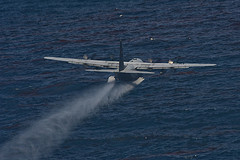Gulf spill: BP gets go ahead for full-scale underwater use of dispersants
Approval can be pulled if harm outweighs benefits
All week, U.S. federal agencies have been evaluating an unprecedented use of oil dispersants: to break up crude spewing from the seafloor. BP won preliminary approval to try them in limited tests against an ongoing torrent of oil spewing from the base of a devastated exploration rig in the Gulf of Mexico. Late morning on May 15, the Environmental Protection Agency and the Coast Guard issued their joint approval for a scale-up of the novel subsea application of these chemicals.

“Based on the scientific analysis of the EPA and National Oceanic and Atmospheric Administration and review by the National Response Team, it has been determined that the use of dispersants at the subsea source is the prudent and responsible action to take along with other tactics including surface dispersant, skimming and controlled burns,” said Coast Guard Admiral Thad W. Allen, the spill’s national incident commander.
Dispersants have been employed widely to treat surface oil spills. But in a May 12 briefing, EPA Administrator Lisa Jackson noted that things are so bad in the Gulf right now that all reasonable emergency measures must be considered – including the experimental use of dispersants undersea, before oil reaches the surface.
At the time, EPA gave BP a preliminary go ahead for small-scale experiments of the chemicals’ subsea use, but only as long as the company also monitored the dispersants’ effectiveness. Those tests confirmed, EPA now reports, that injecting these chemicals into the billowing underwater plume cut the amount of oil reaching the surface. Moreover, the agency noted, this tactic used “less dispersant than is needed when the oil does reach the surface.”
And that’s good since the two approved dispersants (used interchangeably, depending on availability) are toxic. But only about a tenth to one-hundredth as toxic as the oil to which they’re being applied, noted NOAA director Jane Lubchenco at the May 12 briefing.
Moreover, Jackson points out, dispersants tend to biodegrade much more rapidly than crude oil does.
Her EPA colleague Dana Tulis added that to safeguard nearshore areas from any dispersant-related harm, these chemicals may not be used within three miles of the U.S. coastline or where water is less than 10 meters deep.
Like a detergent, dispersants help break big quantities of oil into tiny droplets, even microdroplets. The idea has been that by injecting them into the river of oil that has been gushing unchecked from the seafloor since the April 20 explosion and sinking of the Deepwater Horizon exploratory rig, these chemicals might limit the quantity and intensity of oil that reaches land and threatens to smother fragile wetlands.
Dispersants are also being widely used on the Gulf’s floating slick. Here, they break the surface tension so that wave action can mix the oil into a cloud of tiny droplets that tends to mix into the water column. The resulting increased surface area of the oil allows greater access to the elements for weathering, by which volatile constituents – often the more toxic ones – leave the oil. The crude’s greater surface area also makes it easier for hydrocarbon-loving microbes to chew up and degrade the oil.
To date, an estimated 560,000 gallons of dispersants marketed under the trade name Corexit have been deployed on the Gulf spill and more than 260,000 additional gallons sit in reserve. While BP has now won approval for full-scale underwater use of dispersants, the feds have emphasized that they reserve the right to halt subsea use of these chemicals at any time if it appeared their use poses more harm than benefit.






